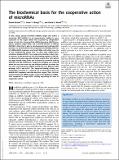The biochemical basis for the cooperative action of microRNAs
Author(s)
Briskin, Daniel; Wang, Peter Y; Bartel, David P
DownloadPublished version (2.117Mb)
Publisher Policy
Publisher Policy
Article is made available in accordance with the publisher's policy and may be subject to US copyright law. Please refer to the publisher's site for terms of use.
Terms of use
Metadata
Show full item recordAbstract
© 2020 National Academy of Sciences. All rights reserved. In cells, closely spaced microRNA (miRNA) target sites within a messenger RNA (mRNA) can act cooperatively, leading to more repression of the target mRNA than expected by independent action at each site. Using purified miRNA-Argonaute (AGO2) complexes, synthetic target RNAs, and a purified domain of TNRC6B (GW182 in flies) that is able to simultaneously bind multiple AGO proteins, we examined both the occupancies and binding affinities of miRNA-AGO2 complexes and target RNAs with either one site or two cooperatively spaced sites. On their own, miRNA-AGO2 complexes displayed little if any cooperative binding to dual sites. In contrast, in the presence of the AGO-binding region of TNRC6B, we observed strong cooperative binding to dual sites, with almost no singly bound target RNAs and substantially increased binding affinities and Hill coefficients. Cooperative binding was retained when the two sites were for two different miRNAs or when the two sites were bound to miRNAs loaded into two different AGO paralogs, AGO1 and AGO2. The improved binding affinity was attributable primarily to a reduced rate of dissociation between miRNA-AGO complexes and their dual-site targets. Thus, the multivalent binding of TNRC6 enables cooperative binding of miRNA-AGO complexes to target RNAs, thereby explaining the basis of cooperative action.
Date issued
2020Department
Whitehead Institute for Biomedical Research; Howard Hughes Medical Institute; Massachusetts Institute of Technology. Department of BiologyJournal
Proceedings of the National Academy of Sciences of the United States of America
Publisher
Proceedings of the National Academy of Sciences